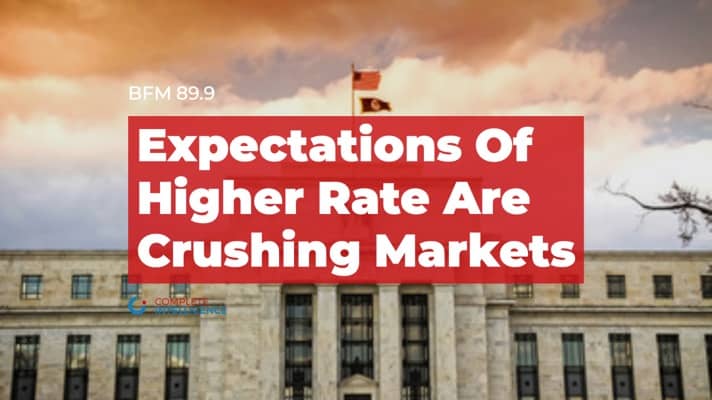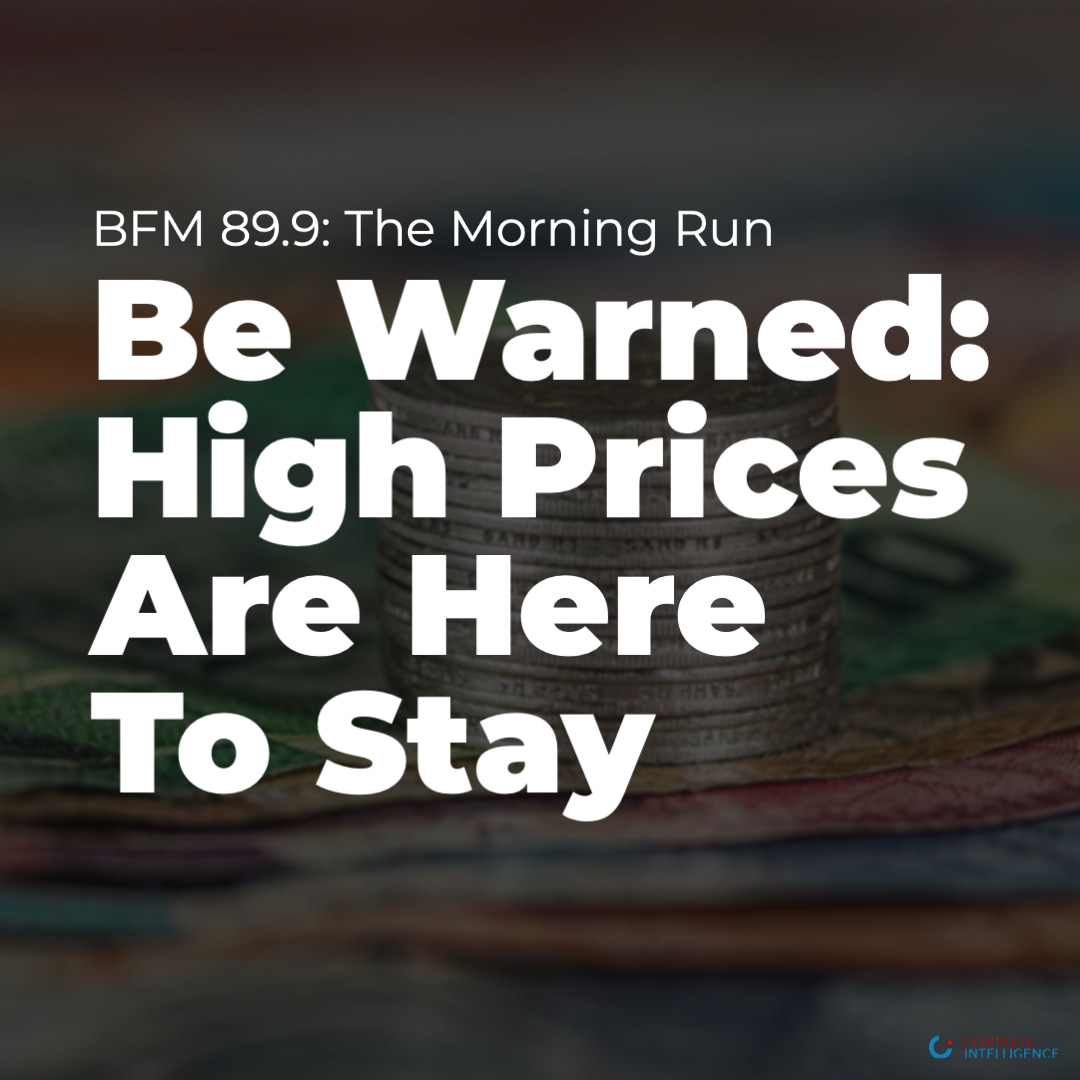Markets are tanking on concerns that rate hikes might occur sooner than expected, hence the possibility that heightened volatility and a flight to value havens could be in store for 2022, according to Tony Nash, CEO, Complete Intelligence.
This podcast first appeared and originally published at https://www.bfm.my/podcast/morning-run/market-watch/expectations-of-higher-rate-are-crushing-markets on January 5, 2021.
Show Notes
KHC: Good morning. This is BFM 89 nine, five minutes past seven in the morning, 6 January 2022. I’m Khoo Hsu Chuang and I’m joined by Philip See. Okay, let’s also recap how global markets closer today, Phil.
PS: Yeah. Markets in the US really didn’t enjoy the fair minutes. So the Dow is down 1% SMP 500 down 1.9% Nasdaq also down 3.2% across over in Asia mixed the Nikkei was up zero 1% Hang Sing down 1.6% Shanghai Composite down 1% Singapore STI down 6%. But back home as FBMKLCI was up zero 4%.
KHC: Of course, markets are being rented all over the world because of the Fed minutes, which disclose that JPowell might introduce higher rates as early as March. So for some thoughts on what’s moving these markets, we now talk to Complete Intelligence Chief Executive Tony Nash. Tony, good morning. Now we are talking about how financial markets are being crushed everywhere, including in the US by the Fed minutes, which is just faster and higher rate hikes. Maybe as early as March. Do you share the same sentiment?
TN: Yeah. I think it’s a little bit weird. So it makes sense for the Fed to stop buying things. So they buy, like mortgage backed securities so that they can put money into the market. So those are things that go onto their balance sheet. So they’ve acquired trillions of dollars worth of assets in order to support markets and get money into the system. So it makes sense to taper off the things they buy. But it doesn’t make sense to raise interest rates because people are complaining about inflation.
Right. And so if people can’t afford stuff, the major issue is stop putting money into the market don’t necessarily raise the cost of money, which is what interest rates are. So the markets feel like Powell has things a little bit out of order and that he needs to just stop putting money in the market before he raises rates. It may be appropriate to raise rates later in the year, but not just yet. So people think this is a little bit preemptive. So I would expect to see statements to walk back this Fed meeting over the next couple of days or week.
KHC: Well, the thing, Mr. Tony, according to the Bloomberg and markets being the forward indicators, that they are the Bloomberg, that there’s going to be a 71% chance that there’s going to be a rate hike as early as the March 16 meeting for the FOMC. What do you make of that?
TN: I see that. But that’s a forecast by economists. So I’d love to see the error rates of the economists. So I think that the real expectation is around the market welcoming of that. So is it possible they raised by March? Yeah, it’s possible. I think they need to start the paper first to see how likely it is, because again, the major issue is inflation and raising interest rates is a very old school way of fighting inflation before we had the tools that we have right now brand QE QE and other things.
PS: So getting a perspective. Clearly, what we saw in the nest was 3% down. I think interest rate sensitive stocks like tech stocks, I think were biggest hit. Is it time to take some money off the table after a good run?
TN: Sure. Yeah. That’s definitely part of the calculation. Absolutely.
PS: And then the question is, do you rotate it into value?
TN: Well, I think what we’re expecting probably sooner rather than later. We saw some big moves today, but yeah, there is expected irritation out of tech. We’ve seen people load up on tech and durable goods over the past two years. They’re way overstretched. So we do expect tech to see some serious downside over the next quarter, two quarters. And we do expect a rotation more into traditional industries, what people would consider boring industry. So people who make stuff like actually make stuff, even things like tourism and those sorts of things.
So we expect to do some rotation there.
KHC: Yeah. Tony, the other spectre is obviously the covered variants. IHU and of course Florona as well. Assuming that you are right in the possibility of the Fed walking back comments about the March rate hike or the possibility of a March rate hike. Right. What would the smart money be doing now in terms of possibly buying to the dip and getting a nice bounce from a short term trading perspective?
TN: Well, I think you have to look at things like energy, which has gotten a lot of attention over the past week. I think you have to look at what opportunities will there be if the variant slows down and money remains cheap. Okay. So if we’re not going to see a dramatic rise in interest rates from the Fed, then you may have some legs on some things like real estate. I’m not sure. But you may I’d have to do some research there, but I think you really need to look at things like tourism and people getting out Airlines.
Those sorts of things really have to think about when people start to get out in force, what kind of difference can be made in markets?
KHC: I think you quite rightly pointed out that increasing interest rates is a very old fashioned way of dealing with inflation. What, in your opinion, are possibly alternative solutions to addressing higher costs, which is definitely a reality today.
TN: Look, a lot of the issue is on the supply side. So you raise interest rates when the issues are on the demand side and the demand side peaked in 2020 after the Fed just released a huge amount of money on to US citizens. So a lot of the issues are supply chain issues, and they’re on the supply side. So better to reduce or taper off the supply of money going into the system and focus on building out supply chain so if there were an infrastructure bill that came and said, we’re going to focus on these supply chains and make them more robust.
And we’re going to focus on near shoring manufacturing to reduce the length of the sophistication of those supply chains. I think that’s really all that they can do right now to focus on that supply side. So in short, interest rates aren’t going to help. There has to be a more medium and long term investment in Shoring up the supply side. Yeah. I agree with you.
PS: I think that’s a very medium long term outlook. And I just wondering how earnings will look like this year.
TN: Well, certainly not going to look like 20 or 21. A lot of the 21 interest earnings were up until, say Q3, there were effects based on expenses that were cut in 20. There was a lot of headcount reduction and real estate reduction in 20 because of work from home and staff reduction, those sorts of things. So 22 is going to be harder. It’s going to be a much more disciplined old school efficiency, automation and top line growth type of environment.
KHC: Well, Tony, given that we are only six years, six days into the new year, how should asset allocation strategies look like for the conservative investor in 2022?
TN: You know, you’ve got to really be careful of volatility and you’ve got to be careful of risk, even things like political risk, which is what’s happening in Kazakhstan today. We really have to be careful of political risk in market. So with the events in Kazakhstan, then I think you’ll start to see people really take another look at Em and try to figure out how much risk are in those investments. You may see people steer away from em because of that risk. So I think you’re going to see more consideration for developed markets.
You may even see more consideration for Europe. I think Europe may have a good year this year.
PS: And I wonder if there’s a consideration for traditional safe havens like gold, US dollar and treasury spend.
TN: Yeah. Well, that certainly supports the dollar, Treasuries and so on. Gold. I’m not so sure about gold may have some upside, but the focus on developed markets may will definitely support the US dollar and Treasuries.
KHC: All right, Tony, thank you so much for your time. And that was Tony Nash, the chief executive of Complete Intelligence, talking about the Fed minutes, which I have perturbed markets in a significant way.
PS: I think markets are factored in the tapering, but not the interest rate moving earlier.
KHC: Yeah.
PS: That’s why you saw the tech heavy Nasdaq really hit quite badly with 3.2% decline.
KHC: Yes. And of course, we saw the Bloomberg indicators surveying economists a 71% chance that there’s going to be a rate hike at the March 16 meeting.
PS: Incredible.
TN: Right.
PS: You know, you talk about just four or five months ago, we were talking about only two hikes at best, in June. And now we’re seeing things shift very fast.




